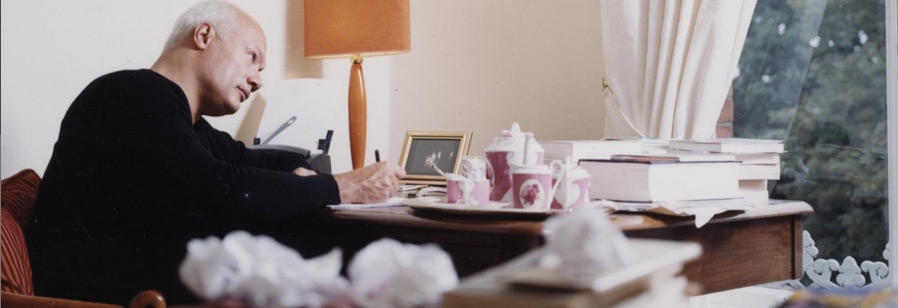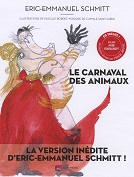Masterclass
Trailers
Monsieur Ibrahim et les Fleurs du Coran
x (x)
x (x)
x (x)
x (x)
x (x)
x (x)
View all trailers
Summary
Camille Saint-Saëns’ masterpiece as conceived by Eric-Emmanuel Schmitt.
The book you are about to read naturally has a tale to tell, but it is a tale which, rather than accompanying the music, will open your ears the better to hear it.
Music doesn’t describe the world like a painting, a photo or the cinema: it has its own life and unique charm. But sometimes, it likes to reproduce elements from nature – a donkey braying, a cock crowing, or a cuckoo’s call. It suggests shapes, movement and colours, whimsically turning melodies we’ve heard before into turtles, elephants or dinosaurs.
Camille Saint-Saëns’ masterpiece as conceived by Eric-Emmanuel Schmitt.
Illustrated with over 40 original watercolours by Pascale Bordet.
Narrated by Anne Roumanoff with music by Camille Saint-Saëns performed by the chamber orchestra directed by Pascal Amoyel.
Reviews
Baz'art - « A splendid literary-musical adventure »
I want to talk now about your second book: your highly personal version of Carnival of the Animals. Firstly, congratulations on producing a work that’s beautiful on so many levels, a splendid literary-musical adventure with beautiful illustrations by Pascale Bordet. I listened to the book with my children aged 5 and 8 and they were enthralled, particularly by the verse text, which they memorised word-for-word the first time they heard it! This is the third literary-musical adventure after My Life with Mozart and When I Think that Beethoven is Dead When So Many Morons Are Alive ….
Why, after the two “stars” of classical music, Mozart and Beethoven, did you go for a composer who isn’t nearly as well recognised by the general public, Camille Saint-Saëns?
Eric-Emmanuel Schmitt:
Firstly, thank you very much for your compliments, which are extremely kind and make three years’ intense work and the whole collective adventure worthwhile!
Actually, I’d started out with the same intention I’d had with Mozart and Beethoven, to explode the clichés about classical music (considered the preserve of the elite, which is a complete fallacy, in my opinion) and to teach people to open their ears and listen to the music with a literary accompaniment that would facilitate that approach.
Saint-Saëns was a prolific composer, and most of the music he wrote was totally serious, so Carnival of the Animals is a bit of an outlier in his oeuvre, because it’s a fantasy about animals and supposed to be fun. I’ve known the music since I was 15, when I first heard it in a whimsical version by Francis Blanche, but for me, that version was problematic, because it worked separately from the music, it was too independent of the music.
I’ve got quite a few musician friends who deplore the fact that there are no words to help people listen to this superb piece of music, and it was with that objective that I set out to write this book.
Music may not depict the world the way paintings or films do, but it can nevertheless reproduce certain natural elements, like a donkey braying, a cockerel crowing or a cuckoo calling, and my poems are there to marry up those parallels, a bit like Prokoviev’s Peter and the Wolf.
And I’m fully aware how much children love verse, and what you say about your children’s appreciation doesn’t surprise me, which doesn’t mean I’m not thrilled.
Baz’art:
And your book is also an ode to artistic creation because Saint-Saëns’s creative genius and cunning would seduce princesses and give him the edge over his handsome peers, as he himself was considered physically ugly. Anyway, frankly, was Saint-Saëns really as ugly as all that?
Eric-Emmanuel Schmitt:
(Laughs) Oh, well, he was no great shakes, but I laid it on a bit thick, I admit. But yes, you’re right, what I also wanted to tell children who read and listen to this Carnival of the Animals was that, in this society where the cult of appearance is so important, talent, whatever it is, but artistic talent specifically, will always win out over physical attraction. It’s vital for me to communicate that to younger generations.
Baz’art:
One final word about the book and Pascale Bordet’s splendid illustrations. How did you come to use her, and how did that collective project go?
Eric-Emmanuel Schmitt:
It was actually a rather unusual encounter, because Pascale Bordet is, for me, the greatest costume designer alive (there’s going to be a programme about her on France 5, by the way), and I’ve been working with her for my plays for many years.
As she was in the habit of producing beautiful watercolours for her models, I talked to her about the idea and told her I was keen for her to illustrate the book with about 40 watercolours, to show the different postures of the animals according to the music and my poems.
She’d never actually had any of her watercolours published, but she agreed to go along with me, and I think what she produced is truly remarkable. I’m very proud of her illustrations.
Baz’art:
One extra question, which has nothing to do with your current work: I notice that, like me, you love Pedro Almodovar’s work. If so, are you going to be at next week’s Film Festival in Lyon (the “Festival Lumière”), given that Almodovar will have pride of place at it this year and, as a native of Lyon yourself, you presumably often go back home?
Eric-Emmanuel Schmitt:
Unfortunately, no. My schedule is too full for me to go down to Lyon this week, but I’m bitterly regretful … Because, it’s true, I just love Almodovar’s films, the same as I do Woody Allen’s. I go to all his films, and even the ones that aren’t so good make me want to go back and see another one by him. Almodovar is a film director who’s more about script than direction, which I suppose is why I like him. If there’s one film I’d recommend you to see, it would be Law of Desire (1987), which brings together all his obsessions and which is breathtakingly beautiful…
Baz’art:
Well, that’s timely! Law of Desire is on the programme of the Festival and I was thinking of going to see it (smiles). Thank you very much, Eric-Emmanuel, for this wonderful interview, and all the best for your books and plays currently being promoted. Come and see us in Lyon again soon!
Philippe Hugot
France musique.fr - « Carnival of the Animals »
CD and book: Saint-Saëns’ Carnival of the Animals with words by Eric-Emmanuel Schmitt, narrated by Anne Roumanoff
Camille Saint-Saëns’ masterpiece
Imagined by Eric-Emmanuel Schmitt
Narrator: Anne Roumanoff
Music director: Pierre Amoyel
Eric-Emmanuel Schmitt has always loved the music of Carnival of the Animals and Camille Saint-Saëns’ humour. He first came across the suite in the version by Francis Blanche, but he was not entirely convinced: “I was sorry the words worked alongside the music but didn’t make you listen to it more – they didn’t unveil Saint-Saëns’ remarkable composition. So, I wrote this new version in verse, because children love the fanfare of poetry, although it’s for grown-ups as well as children. My aim is to show how Saint-Saëns conjures up animals from instruments, how he creates a tune out of the ghastly sound of a donkey braying, or from the two notes of a cuckoo call or the silence of a swan, how he represents an aquarium on two pianos and fossils from old melodies.” In the form of a story, Eric-Emmanuel Schmitt takes us on a journey that goes to the very heart of the musical composition.
WITH:
Eric-Emmanuel Schmitt has added music to this new book, which comes with a CD. The narrator is Anne Roumanoff. Music recorded by France Musique and played by Pascal Amoyel accompanied by:
Pierre-Laurent Bouchariat, piano
Philippe Bernold, flute
Florent Heau, clarinet
Christophe Giovaninetti
Louise Salmona, violin
Pierre-Henri Xuereb, viola
Emmanuel Bertrand, cello
Gilles Ranticelli, percussion
Yann Dubost, double bass.
The book is illustrated with over 40 original watercolours by Pascale Bordet, a costume designer.
La bibliothèque de Jake - « This book is truly wonderful »
Carnival of the Animals – Eric-Emmanuel Schmitt
By Jake Vecchiet, 6 October 2014
Features:
Type: Novel
Large format book: 72 pages, €22.90
Includes a CD
Summary
Eric-Emmanuel Schmitt tells a superb story based on Saint-Saëns’ animal fantasy composed in 1886. With remarkable invention, Saint-Saëns depicts the calls, movements and other features of several animals in musical notation. Eric-Emmanuel Schmitt has produced a funny and coherent story, interspersing the musical portraits with little poems.
Lolo’s opinion:
This book is truly wonderful. The embossed drawings on the front and back cover are splendid. Poems, animals and watercolours alternate, and the watercolour illustrations are just magnificent. They are witty, colourful and expressive. The verses are clear and written in capitals, each one taking up a page at most. But the really remarkable thing is the overall effect: the words and music together form the most amazing marriage. Saint-Saëns reproduces a cuckoo’s call from two notes. The Swan alone is magical, but you can literally see all these animals on the basis of a few musical notes, which is incredible. The donkey braying is also noteworthy. The cherry on the cake has to be Anne Roumanoff, the narrator on the CD that comes with the book, and frankly, you’d think the verses had been written for her! This magnificent Carnival of the Animals is an absolute gem. It will delight adults and children alike, because everyone can give free rein to his or her imagination.
bernieshoot.fr - « An outstanding version »
For me, Carnival of the Animals represented above all Camille Saint-Saëns’ music. I remember that suite of 14 movements, with the “March of the Lions” and “Elephants” standing out in particular. The work is unique for the way it succeeds in portraying animals in music.
Eric-Emmanuel Schmitt has produced an outstanding version that will cocoon you in Camille Saint-Saëns’ score. Everyone knows he can be funny, and I was curious to know how he was going to marry his humour with Saint-Saëns’ fantasy.
Impossible to be disappointed, because, not only did I rediscover the music, but all 14 pieces came straight back to me. But I’m running on, because I forgot to say that not only will you have Eric-Emmanuel Schmitt’s witty style and all his rhymes to savour, but you will also have Pascale Bordet’s magnificent watercolours to delight your eyes, the whole thing topped off by a CD of Saint-Saëns’ music with verses narrated by Anne Roumanoff.
A three-pronged masterpiece that’s absolutely unmissable. So, insert the CD, kick back on a comfy sofa and pick up the book for a glorious hour of Saint-Saëns’ musical portraits of animals enhanced by Schmitt’s verses narrated by Anne Roumanoff and delightfully illustrated by one of the greatest watercolourists.
Eric-Emmanuel Schmitt dramatizes the composer who’s in thrall to the charms of three beautiful women. But, of course, Saint-Saëns is the one to call the shots with his wit and elegance.
Anne Roumanoff is superb as the narrator, adopting just the right tone for the words and rhymes. Her voice is ideally suited to this collection of poems. I don’t know whether she has already done voice-overs for films but that would easily be another string she could add to her bow.
I can’t resist introducing you to the watercolour of the elephant (on the book jacket) “heavy when others are light, crawling when others fly.”
So, it’s a funny, witty, heady mix with, now and then, just a hint of impertinence.
A musical and literary adventure which I thoroughly recommend.
Bernie Shoot


